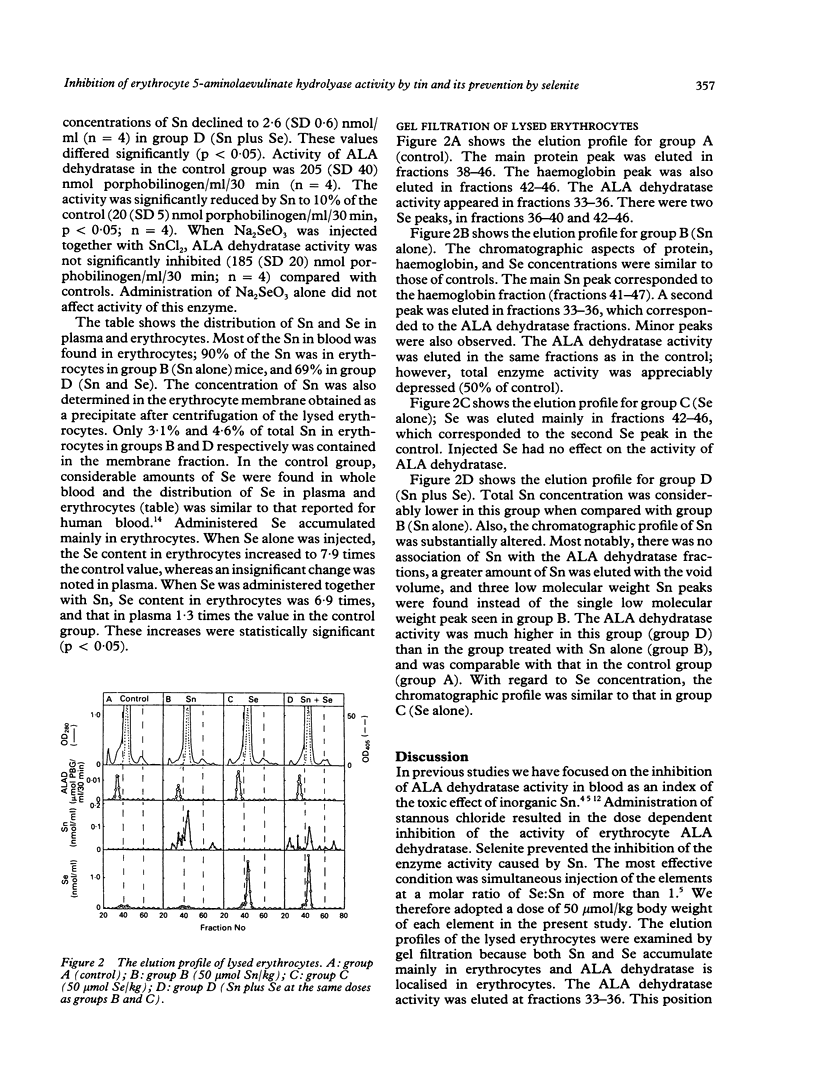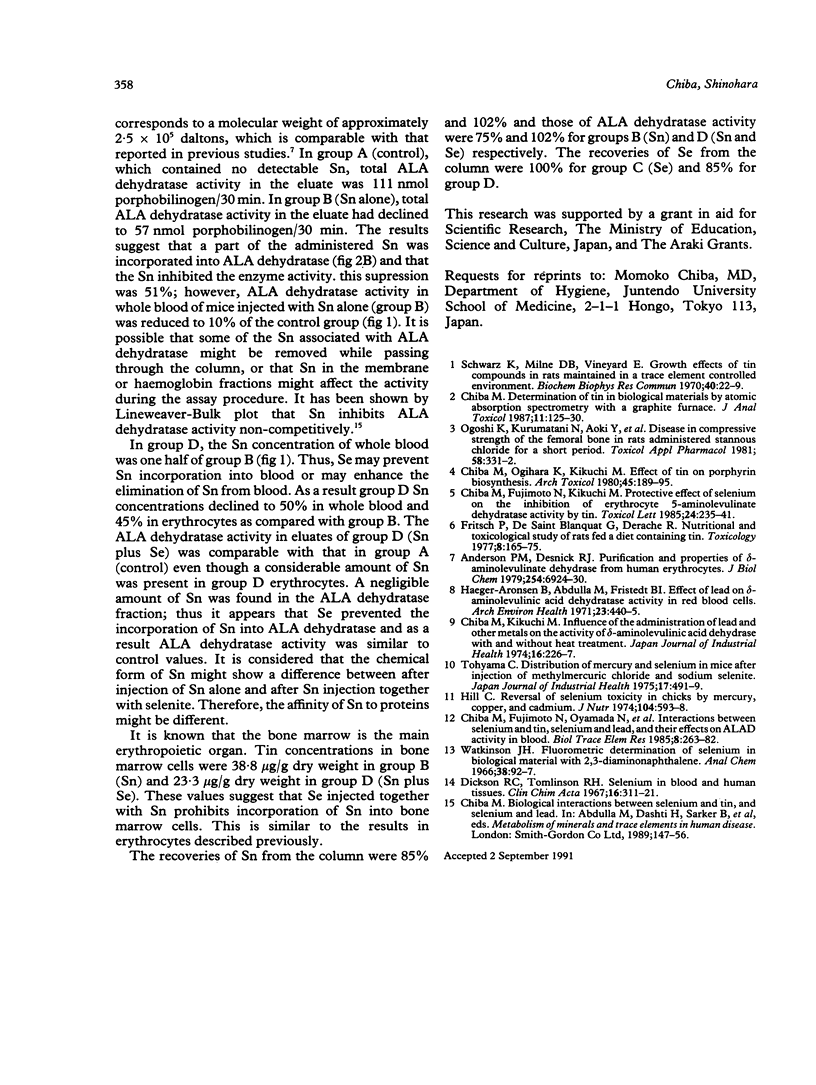Abstract
Mice were injected with either SnCl2 (intraperitoneal) or Na2SeO3 (subcutaneous) alone or together at doses of 50 mumol/kg body weight. After 20 hours blood was collected and the concentrations of tin (Sn) and Selenium (Se) and the activity of 5-aminolaevulinate hydrolyase (ALA dehydratase, EC 4.2.1.24) in blood were determined. The concentrations of Sn in whole blood were 4.9 (SD 1.5) nmol/ml (n = 4) and ALA dehydratase activity was 10% of the control in Sn treated animals. Concentrations of Sn were 2.6 (SD 0.6) nmol/ml and ALA dehydratase activity was 92% of that in control animals when Sn and Se were simultaneously injected. The supernatant from lysed erythrocytes from Sn treated mice were applied to a Sephacryl S-300 column. The predominant peak containing Sn was eluted at the position of haemoglobin; a second peak was eluted at the position of ALA dehydratase. When the supernatant of lysed erythrocytes from mice injected with Sn and Se was chromatographed, a negligible amount of Sn was detected in the ALA dehydratase fraction. It thus appears that Sn binds to ALA dehydratase molecules and inhibits enzyme activity, and that simultaneous injection of Se prevents Sn binding to ALA dehydratase, thereby preventing the inhibition of ALA dehydratase activity by Sn.
Full text
PDF



Selected References
These references are in PubMed. This may not be the complete list of references from this article.
- Anderson P. M., Desnick R. J. Purification and properties of delta-aminolevulinate dehydrase from human erythrocytes. J Biol Chem. 1979 Aug 10;254(15):6924–6930. [PubMed] [Google Scholar]
- Chiba M. Determination of tin in biological materials by atomic-absorption spectrometry with a graphite furnace. J Anal Toxicol. 1987 May-Jun;11(3):125–130. doi: 10.1093/jat/11.3.125. [DOI] [PubMed] [Google Scholar]
- Chiba M., Fujimoto N., Kikuchi M. Protective effect of selenium on the inhibition of erythrocyte 5-aminolevulinate dehydratase activity by tin. Toxicol Lett. 1985 Feb-Mar;24(2-3):235–241. doi: 10.1016/0378-4274(85)90063-3. [DOI] [PubMed] [Google Scholar]
- Chiba M., Ogihara K., Kikuchi M. Effect of tin on porphyrin biosynthesis. Arch Toxicol. 1980 Sep;45(3):189–195. doi: 10.1007/BF02418997. [DOI] [PubMed] [Google Scholar]
- Dickson R. C., Tomlinson R. H. Selenium in blood and human tissues. Clin Chim Acta. 1967 May;16(2):311–321. doi: 10.1016/0009-8981(67)90197-0. [DOI] [PubMed] [Google Scholar]
- Fritsch P., de Saint Blanquat G., Derache R. Etude nutritionnelle et toxicologique, chez le rat, d'un contaminant alimentaire: l'etain. Toxicology. 1977 Oct;8(2):165–175. doi: 10.1016/0300-483x(77)90005-1. [DOI] [PubMed] [Google Scholar]
- Haeger-Aronsen B., Abdulla M., Fristedt B. I. Effect of lead on -aminolevulinic acid dehydrase activity in red blood cells. Arch Environ Health. 1971 Dec;23(6):440–445. doi: 10.1080/00039896.1971.10666033. [DOI] [PubMed] [Google Scholar]
- Hill C. H. Reversal of selenium toxicity in chicks by mercury, copper, and cadmium. J Nutr. 1974 May;104(5):593–598. doi: 10.1093/jn/104.5.593. [DOI] [PubMed] [Google Scholar]
- Ogoshi K., Kurumatani N., Aoki Y., Moriyama T., Nanzai T. Decrease in compressive strength of the femoral bone in rats administered stannous chloride for a short period. Toxicol Appl Pharmacol. 1981 Apr;58(2):331–332. doi: 10.1016/0041-008x(81)90437-3. [DOI] [PubMed] [Google Scholar]
- Schwarz K., Milne D. B., Vinyard E. Growth effects of tin compounds in rats maintained in a trace element-controlled environment. Biochem Biophys Res Commun. 1970 Jul 13;40(1):22–29. doi: 10.1016/0006-291x(70)91040-5. [DOI] [PubMed] [Google Scholar]
- Watkinson J. H. Fluorometric determination of selenium in biological material with 2,3-diaminonaphthalene. Anal Chem. 1966 Jan;38(1):92–97. doi: 10.1021/ac60233a025. [DOI] [PubMed] [Google Scholar]


